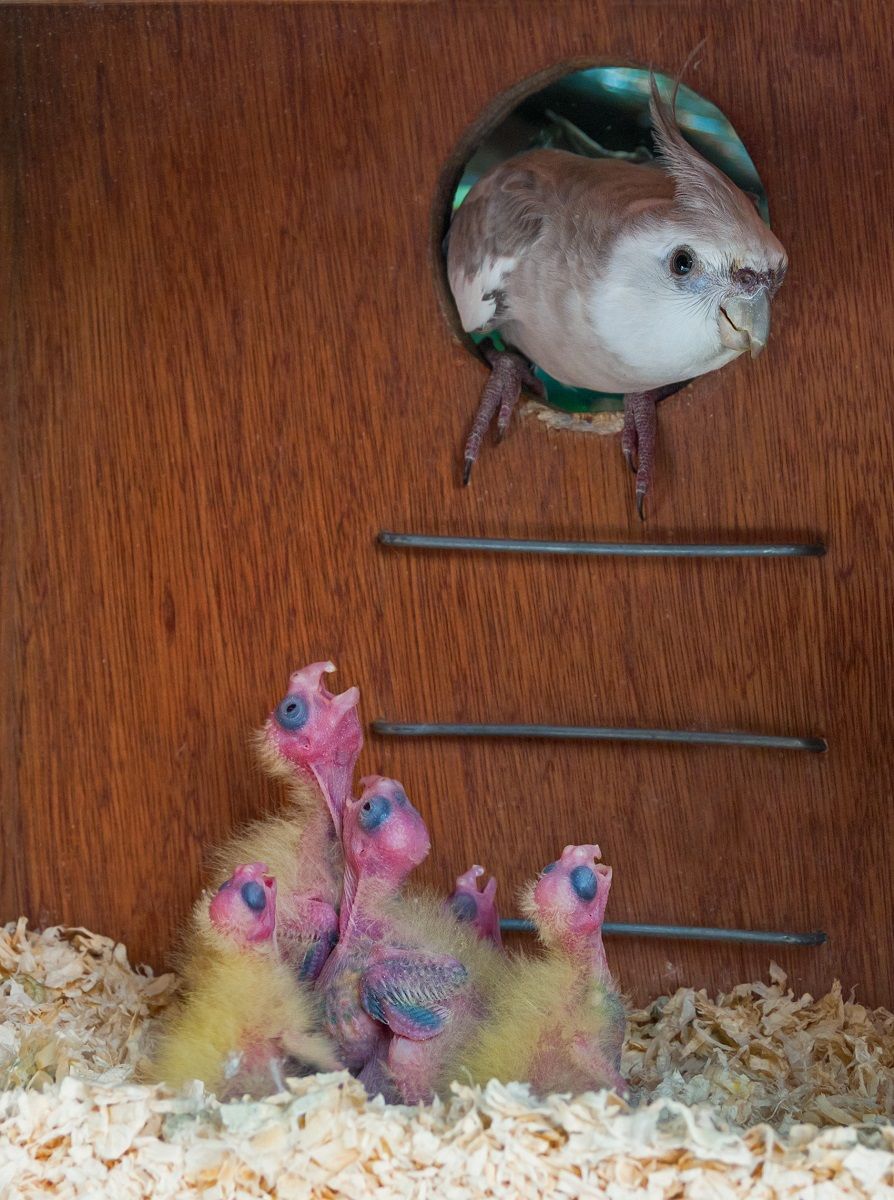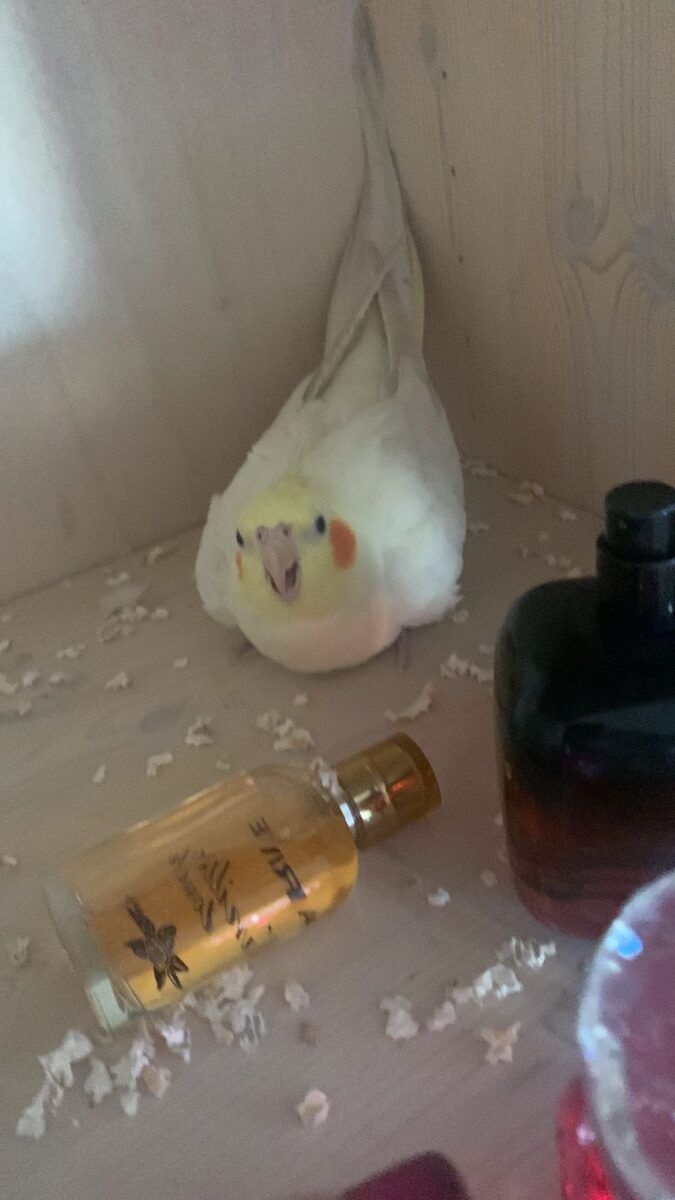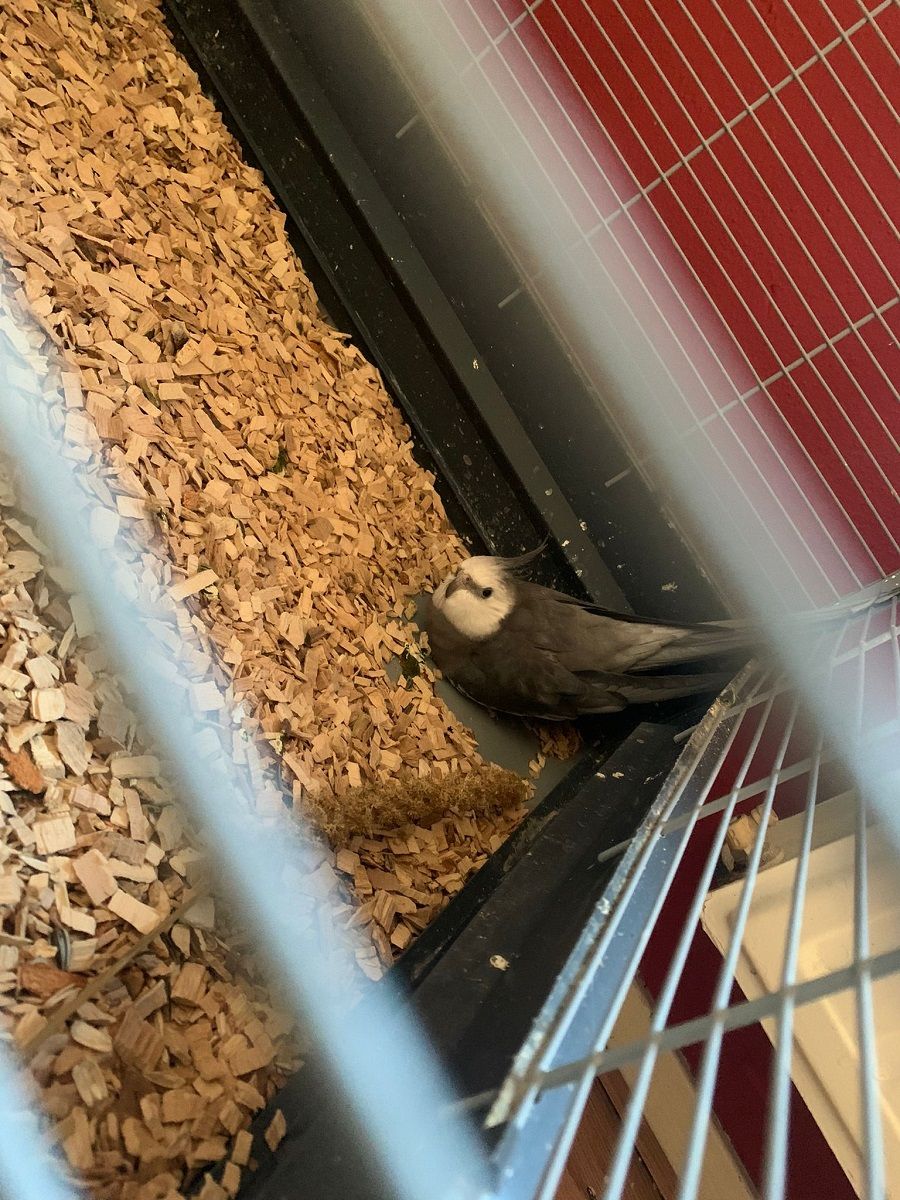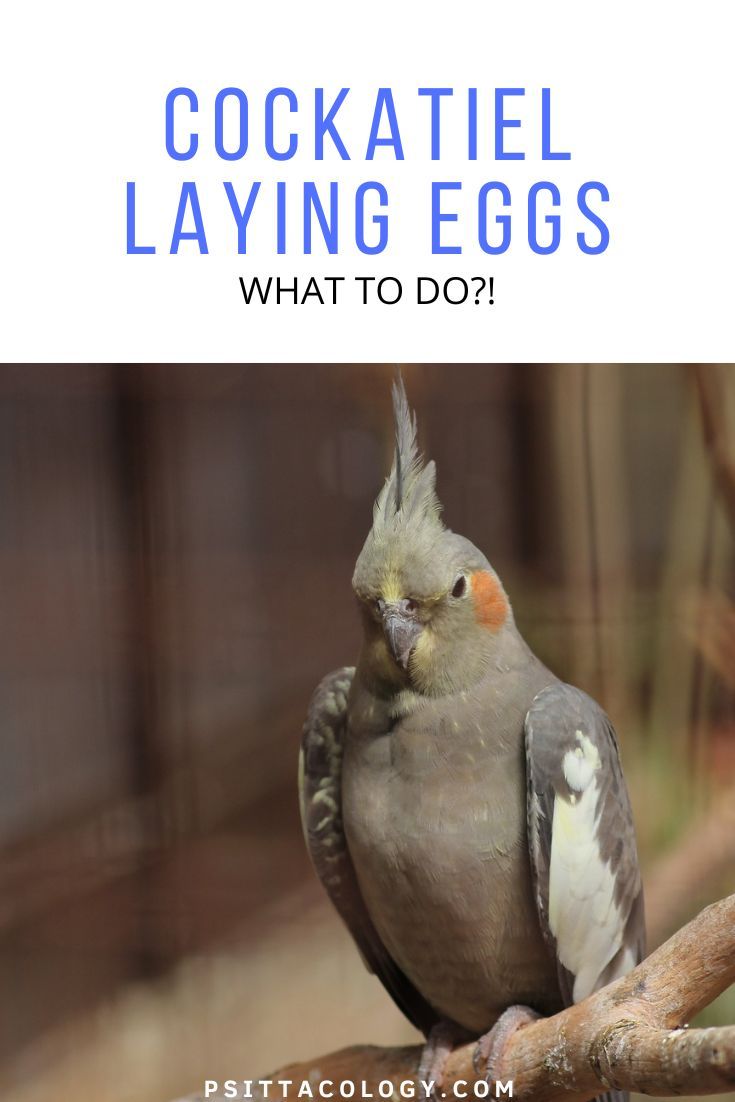Did you know that, like chickens, female cockatiels can lay eggs even without a male present? Whether you’ve got a solo female cockatiel or a broody pair, dealing with a cockatiel laying eggs can be complicated.
The female needs special nutrition, your birds’ behavior can completely change, and what are you supposed to do if the eggs hatch?! Unfortunately, there’s even a risk of serious health complications.
In this article, let’s have a look at everything you need to know about what to do when your cockatiel is laying eggs.
This post contains affiliate links. If you make a purchase, a small percentage will go directly to Psittacology at no additional cost to you. Thank you for supporting Psittacology!
Cockatiel reproduction in the wild
As always when it comes to parrot care – and pet care in general – having a look at how our domestic animals would have lived in the wild can provide some good insights into why they do what they do. It can also help us figure out how to best care for them!
As discussed in the full article on wild cockatiels, these parrots naturally occur in Australia. They’re generally nomadic and prefer open habitats dotted with some trees.
The cockatiel breeding season generally starts in spring and is triggered by rainfall. Pairs, which tend to stay together for life so they don’t have to waste energy finding a new mate every year, will begin courting and mating regularly.
Between flirting and mating, the male will spend time inspecting and clearing out suitable tree hollows. Once everything is in order, the female will lay up to seven eggs. Both parents will help with incubation, taking turns sitting on the eggs and feeding each other.
Once the chicks hatch, care for them is also divided, although the male takes care of most of the feeding. Although they’re born completely defenseless, bald and without the ability to open their eyes, the young grow incredibly quickly. They’re usually fledged and ready to leave the nest after only five weeks.

JJ Harrison (https://www.jjharrison.com.au/), CC BY-SA 4.0, via Wikimedia Commons
Cockatiel pair breeding – what to do?!
This article was originally requested by a cousin of mine, who owns a mated cockatiel pair and was recently confronted with their first attempts at reproducing. So many questions: what do you do with the eggs? What do you feed? How do you manage cranky, broody parrots?
I’m pleased to report the cockatiels in question have forgotten all about nesting and are back to their normal selves. Below, let’s have a look at what we learned, using this little case study as an example!
Should you breed your cockatiels?
First off, I want to stress an extremely important point. As nice as the idea of seeing a bunch of adorable baby cockatiels growing up is, the answer to the question of whether you should breed your birds is NO in 99% of cases.
As such, this guide is not meant to explain how to breed cockatiels. On the contrary, it should hopefully help you minimize the number of eggs laid!
There are a lot of different reasons for this:
- What are you going to do with the babies? There are thousands of cockatiels at rescues waiting for new homes already. Breeding cockatiels is rarely a profitable venture, so don’t think of it as an opportunity to make a quick buck.
- I’m a huge proponent of parent-raised (as opposed to hand-raised) parrots. However, there’s always a possibility you’ll end up having to care for one or more of the young, which is round-the-clock work at first.
- Breeding attempts can end in disaster. How would you feel if one or more of the chicks died? Or even one of the parents? What if a chick dies due to a mistake on your end, which is not uncommon since they’re so fragile?
- If you bought your birds at a pet store, you don’t know anything about their lineage and genetics. That’s not a good start.
- Breeding and raising young is hard on a cockatiel, especially the female. It’s better for her health and that of her mate if you try to prevent egg laying altogether, or at least ensure the eggs don’t hatch.
- Your cockatiels will not be themselves while they go through the process of nesting, incubating the eggs and raising young. They can be aggressive toward you and each other.

My pair is broody!
If you’ve got a male-female cockatiel pair, it’ll be difficult to prevent them from trying to breed altogether. However, as the above makes clear, it’s a good idea to try.
Take precautions to help curb hormonal surges:
- Don’t offer a nest box or anything that could be interpreted as one.
- Make sure your birds get 12 hours of uninterrupted sleep every night.
- Don’t feed protein-heavy foods (like egg food).
- Rearrange the cage on a weekly basis.
You should also avoid petting your cockatiels anywhere other than the head and remove any objects they appear a little too interested in, although if you have a pair, this may not make a lot of difference. Separating them can cause a lot of upset and stress, so that’s usually not an option.
In captivity, cockatiels will usually begin to mate during springtime. The male will court the female any way he can think of: whistles, heart wings, regurgitating food and strutting about. If she’s receptive, he’ll begin to mount his mate regularly, sometimes multiple times a day for a few weeks.
At this time, the pair will likely also begin to show great interest in everything that might look like a nest. A cardboard box? Nest. Space behind the couch? Nest. A drawer left open? Also a nest!
The pair can become territorial about these spaces and begin to shred whatever they can to use as nesting material. It’s best to remove access to these “nests”, not in the least because if the female does lay eggs, you don’t want them inside a kitchen cupboard!

My pair has eggs!
With some luck, your cockatiels will give up if there are no suitable spaces to raise their young. In other cases, the female will opt to lay her eggs on the cage floor or something like a platform perch instead.
Once she begins to spend more time sitting down on flat surfaces, you’ll know the time is near. She may also pluck her own chest feathers. Don’t worry: this is normal behavior that helps them keep their eggs warm more effectively.
Now, different cockatiel owners have different tactics, but the most important thing is to make sure these fertilized eggs don’t hatch. It sounds cruel, but stopping the development of any young before it can really start is what’s best for your ‘tiels (and your sanity!).
Here’s what we did when dealing with Bennie the cockatiel laying eggs:
- When the first egg appeared, we took it away (Bennie was only momentarily upset about this). It was placed in the freezer to stop development and discarded.
- We immediately replaced the single egg with multiple faux eggs (4-5 works well). We hoped this would trick Bennie into thinking she had a full clutch and did not need to lay any more eggs. The ruse worked!
- Bennie and her mate Stanley did a good job incubating, taking turns sitting on the fake eggs. During their “breaks”, they would sit with their owner to preen themselves and then eat as much as they could before feeding their mate.
- We made sure the female had access to calcium blocks and other nutritious foods at all times to make up for the nutrients lost in the process of egg production.
- Normally, cockatiels lose interest in the fake eggs after around a month. Remember, in the wild, eggs don’t always hatch either! At this point, you can remove them.
In this case, we ran into a complication. Inexperienced Bennie and Stanley refused to abandon their eggs! They were clearly exhausted after sitting on them for much longer than usual, and became increasingly aggressive toward each other.
When blood was drawn, we decided to risk removing the clutch. This is not ideal, as we didn’t want Bennie to think she needed to lay a new one, but it ended up being the best decision. The pair quickly lost interest, made up and were back to their old selves within a day.
Tip: Not sure if you’ve got a male and a female? Have a look at the post on sexing a cockatiel to help you find out.

Solo cockatiel laying eggs – what to do?!
As mentioned, you don’t need a cockatiel pair for a female to start laying eggs. If her hormones are triggered, you may find your cockatiel laying eggs all by herself. These eggs are not fertilized and will not produce baby birds.
Although there’s no risk of having to raise a clutch of cockatiels in cases like these, it’s still important to do what you can to discourage a female cockatiel from laying. Producing the eggs is a very taxing process, and there’s always a risk of serious complications (see the paragraph below).
All the same rules apply for egg prevention: no nesting spots, lots of sleep, no high-protein foods, no full-body petting. Rearrange the cage regularly and remove any objects that seem to elicit a sexual reaction (like backing into it, lifting the tail and soft peeping noises).
If despite all this, your female cockatiel has laid an egg, the next steps are similar to those you’d employ with a pair:
- No need to remove the egg, as it’s not fertile. Just add a bunch of fake ones to make her think she’s produced a full clutch.
- Let her sit on the eggs. Make sure she has nutritious food nearby, as normally, her mate would feed her.
- Your cockatiel will likely lose interest after around 3-4 weeks. You can remove the eggs at this point. Don’t do it earlier, as she may lay more to compensate!
- If your bird is still sitting on the eggs after week 5, you could consider removing them one by one over the course of a few days. With some luck, she’ll give up on producing more.

Potential health issues
Throughout this post, I’ve tried to emphasize the importance of preventing your cockatiels from breeding where possible. But what’s so bad about it? Isn’t it natural? Well, it is, but reproduction unfortunately comes at a risk. Female cockatiels especially can develop life-threatening health issues.
It’s important to know what to look out for. If you have a female cockatiel, be vigilant of the following:
Chronic egg laying
Some female cockatiels just don’t stop laying eggs, even in the absence of a mate. Sometimes it’s clutch after clutch, while other times, it’s just a constant stream of eggs. She may not even be interested in incubating them.
Chronic egg laying is a problem, as huge amounts of energy and nutrients are needed to produce them, which can leave the bird completely depleted. Hypocalcemia (lack of calcium), egg binding and other serious problems can occur. These are unfortunately often fatal, especially if you don’t take your bird to the vet.
If your cockatiel produces clutches more than 2-3 times a year despite measures to reduce hormonal behavior, you should also take her to see a vet. In some cases, shots of a hormone called Leuprolide acetate can help resolve the issue.
In extreme cases, a veterinarian may decide to perform a hysterectomy to stop the egg laying altogether. Although this is obviously a pretty invasive procedure and comes with risks, research has shown that it can be done safely.
Egg binding
If your cockatiel isn’t healthy (due to having laid many eggs already, for example), egg binding becomes a risk. This basically means one or multiple eggs are stuck, which can unfortunately be life-threatening.
If your cockatiel is broody, keep a close eye on her. It’s normal for them to act a little strange when they’re about to lay eggs, but if she looks lethargic, puffed up, straining to pass the egg or uninterested in food, something may be wrong.
If you even suspect egg binding, you need to take your cockatiel to an avian vet now. They will do what they can to help her pass the egg. If this is not possible, they may have to break the egg inside the body, which requires internal cleaning afterward to remove any pieces of shell.
You can prevent egg binding by feeding your ‘tiel a healthy diet of high-quality pellets (dry seeds don’t contain enough calcium). Encourage plenty of exercise to prevent obesity, which is another risk factor for egg binding.
And be sure to follow all the steps to prevent hormonal behavior, which is the best way to make sure no eggs form in the first place!
Prolapse
Passing eggs involves a lot of straining, especially in birds that are egg bound. This can lead to cloacal prolapse, which basically means the bits that are supposed to be inside your cockatiel have come out.
Prolapse is usually not difficult to diagnose: you’ll spot a big mass on your bird’s vent. This is usually paired with other common symptoms like lethargy and being puffed up.
As with egg binding, cloacal prolapse requires an immediate vet visit. Not next week, not tomorrow – now. Treatment is possible, but the longer you wait, the riskier it becomes.
Other health issues
There are various other complications associated with a cockatiel laying eggs. None of this is meant to scare you; it’s just important to know what to keep an eye out for.
These include:
- Egg yolk peritonitis: basically, an egg yolk gets “lost” in the body, causing infection.
- Osteoporosis: the amount of calcium used for egg laying can be so excessive that there’s not enough left to sustain your bird’s bones. This causes them to become brittle.
- Seizures: caused by lack of calcium and other deficiencies.
- Impacted oviduct: eggs or pieces of egg get stuck in the reproductive system.
Frequently asked questions
Cockatiel eggs will hatch after around 20 days, give or take a few days.
Clutches of 4-5 eggs are the norm, but there can be a few more or less.
You can check using a technique called candling. Give the potential embryo some time to develop (about 7 days after incubation starts) and then shine through the egg with a bright light. A phone torch works well. If the egg is fertile, you’ll see blood vessels and a tiny embryo outline.
If you have any more questions about what to do about a cockatiel laying eggs, or if you’d like to share your own experiences in dealing with broody cockatiels, don’t hesitate to leave a comment below!
Still looking for more information about cockatiels and their care? Psittacology’s got you covered! You can find everything you need to know in the full cockatiel care guide.
Cover photo attribution: Oldcockatoo, CC BY-SA 3.0, via Wikimedia Commons
Sources & further reading
- Pye, G. W., Bennett, R. A., Plunske, R., & Davidson, J. (2001). Endoscopic salpingohysterectomy of juvenile cockatiels (Nymphicus hollandicus). Journal of Avian Medicine and Surgery, 15(2), 90-94.

